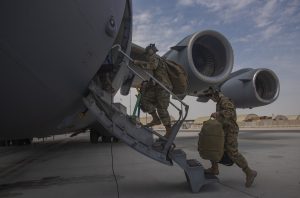By Ezzatullah Mehrdad

May 2021 gave an early taste of the U.S. troop withdrawal from Afghanistan. The United States remained concerned over emerging threats from the country, the Taliban encroached on many provincial centers, and peace talks between the Afghan government and the Taliban increasingly become an aspirational objective rather than a reality.
After 10 years of waging war against the Taliban, and another 10 years of vows to withdraw from Afghanistan, the United States under President Joe Biden finally set September 11, 2021 as a deadline for a full troop exit from the country. U.S. military generals are rushing to not only meet the deadline, but complete the withdrawal as early as mid-July.
U.S. troops have, in large, left the southern provinces of Afghanistan — the Taliban’s heartland. Troops remain at Bagram air base, from which they’ll will pack their final bags. On their way out, U.S. forces are smashing a portion of their equipment, putting some equipment in boxes to ship out, and handing another portion over to Afghan forces.
While U.S. troops draw down for the last time, concerns over the threats against the U.S. and other Western countries remain nearly as sharp as 20 years ago. Even with a deal struck in which the Taliban promised to prevent Islamist groups from using the country as a base to attack the United States, officials and lawmakers in Washington continue to fear attacks by Islamist groups using Afghanistan as a base.
To address those concerns, the Biden administration has been in search of a base in the region from which it can monitor hostile groups. Uzbekistan and Tajikistan have been proposed as options, but Russian influence in Central Asia makes those difficult bases to secure. When talk regarding Pakistan giving the U.S. a base spread, the Taliban swiftly threatened that any government providing the United States a base to operate from would encounter “misfortunes.”
For much of history, Afghanistan has been a mountainous, hard-to-reach place. Twenty years after the U.S. war began, the country is no less remote and arguably no more secure. It remains a likely home for extremists.
Just as the United States remains concerned about how to target emerging threats from the country, a U.S.-backed Afghan Army fighting the Taliban needs support of the United States. Even as it draws down, U.S. aircraft continue to conduct airstrikes in place like Helmand in support of the Afghan Army. As long as the possibility of a Taliban military take over the country persists, the Afghan Army remains in need of U.S. air support.
In the first days of May, the Taliban attacked several provincial centers. In the south, the Taliban began a massive assault on multiple fronts against Lashkar Gah, the center of Helmand province, where the U.S. and British forces previously fought hard campaigns against the Taliban. Ghazni and Qalat, the centers of Ghazni and Zabul province, saw Taliban assaults too. In the north, the provincial centers of Baghlan and Laghman were also assaulted.
The Taliban succeeded in none of their fights over the various provincial centers. The Afghan Army pushed the Taliban back in each case. Nevertheless, the Taliban remain on the edge of provincial centers, posing an imminent threat.
“If the Afghan Army defends provincial centers for 2 to 3 months, the Taliban would lose their morale to fight the army,” said General Atiqullah Amirkhil, a retired army general who commanded air forces for the communist regime against nationwide mujahideen forces. He watched Soviet troops withdraw in 1989.
“The Americans and other Western countries have intentionally let the Taliban attack the provincial centers,” said Amirkhil, “…in a bid to show to the Taliban that the Afghan Army is capable of defending the province centers.”
Defending the provincial centers is but half the story, however. Outposts, checkpoints, and districts in rural areas have been swiftly overrun by the Taliban. In Kabul, the capital, foreign embassies have begun drawing down their staff and closing their offices. The United States was the first to scale down its staff. Then Australia announced it would close it embassy in Kabul over safety concerns.
The beginning of the U.S. troop withdrawal did not lead to any significant progress in the peace talks, which many see as the only path to truly ending the conflict in Afghanistan. Instead, the troop withdrawal seems to have reduced the influence of the United States over the course of the peace talks, which its own agreement with the Taliban kickstarted in 2020. The U.S. proposed-Istanbul conference has yet to take shape.
The Afghan government and the Taliban continued battling over the peace talks. Reportedly, the Taliban attempted to split Afghanistan’s warlords from the Afghan government by trying to make separate deals with each. As a counterpunch, President Ashraf Ghani and his Western-educated team formed a “Supreme State Council” and included influential warlords in to keep them on side.
Former President Hamid Karzai said that Taliban and Afghan government negotiating teams were better off trying to hold talks inside the country, in balmy Bamyan where there is no need for air conditioning in the hot summer, not in sizzling Doha or Istanbul. Karzai said in a political gathering in Kabul that the peace process should become a national process, and that as long as it remains a foreign project it will be less fruitful.
No comments:
Post a Comment